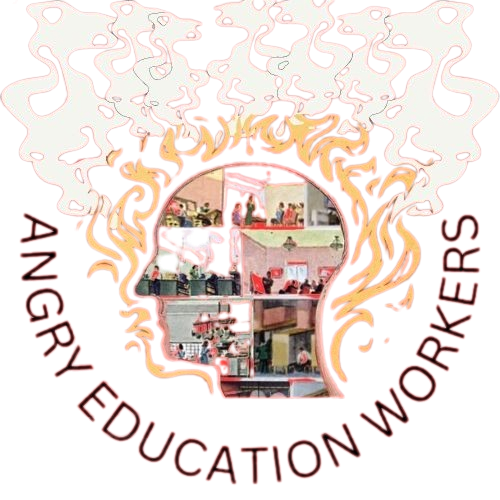A Union for ALL Education Workers!
We in the DC, Maryland, and Virginia Education Workers Organizing Committee (aka DMV EWOC) hope to unite all education workers in the Greater Washington, D.C. metropolitan area to form a militant labor solidarity network.
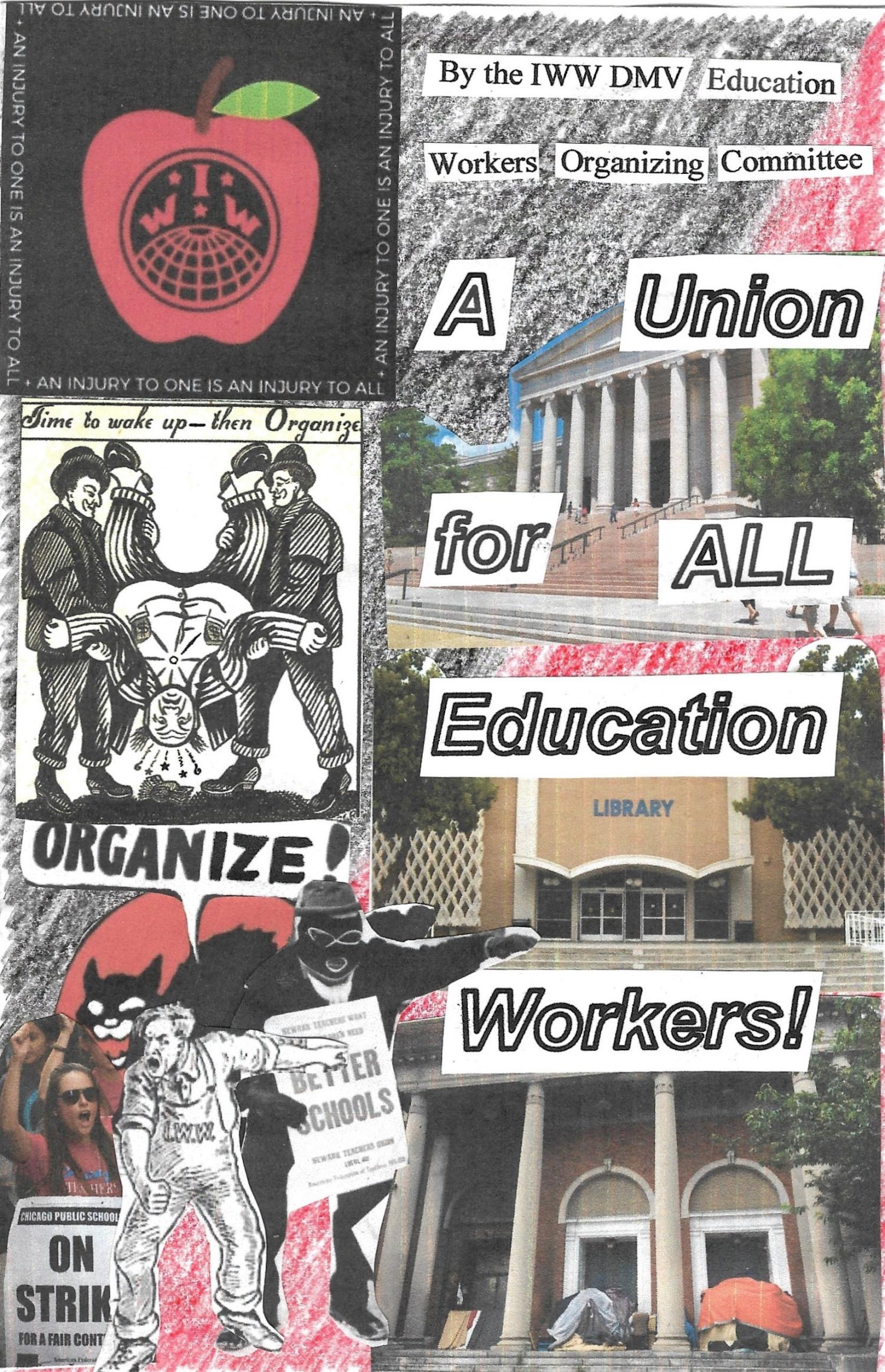
This is a pamphlet collectively written by several members of the DMV Education Workers Organizing Committee (EWOC) to lay out our principles and strategy. It is meant for printing and distributing to the community at any events we table at or host. Feel free to adapt this pamphlet for your own use.
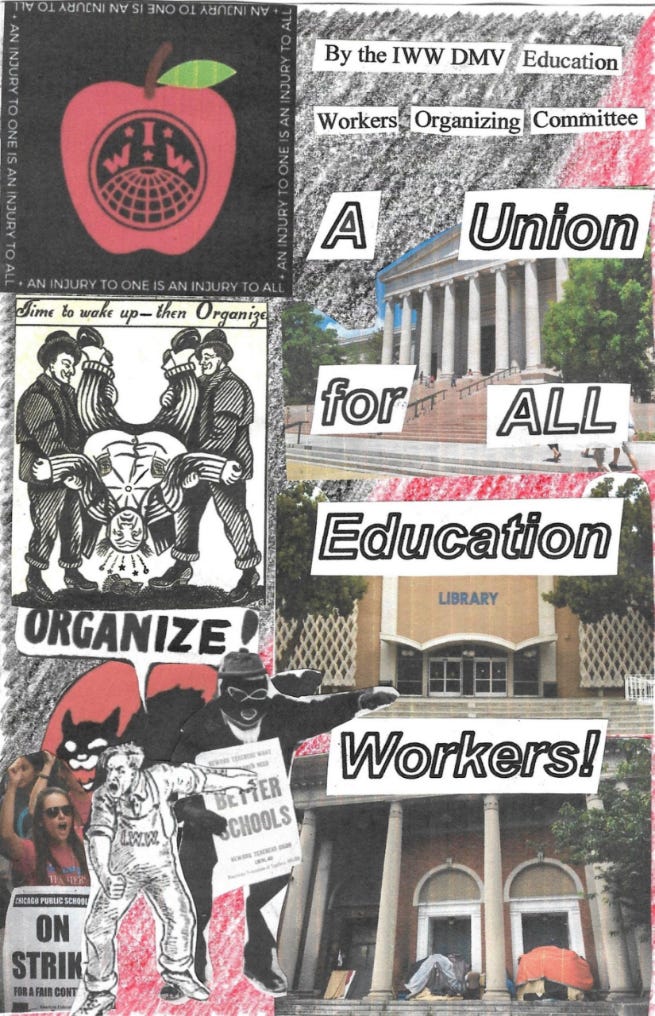
The organization of these workers for mutual aid has shortened the hours of labor, raised and equalized the wages of men and women, and taken the children from the factories and workshops. These humanitarian achievements of the labor unions—and many others which space forbids enumerating—in raising the standard of living of the poorest and weakest members of society are a service to society which for its own welfare it must recognize. More than this, by intelligent comprehension of the limitations of the labor unions and the causes of these limitations, by just, judicious, and helpful criticism and cooperation, society must aid them to feel the inspiration of higher ideals and to find the better means to realize these ideals. If there is one institution on which the responsibility to perform this service rests most heavily, it is the public school.
How shall the public school and the industrial workers in their struggle to secure the rights of humanity through a more just and equitable distribution of the products of their labor, meet their mutual responsibility to each other and to society? Whether the work of coordinating these two great educational agencies, manual and menial labor, with each other and with the social organism, shall be accomplished through the affiliation of the organizations of brain and manual workers is a mere matter of detail and method to be decided by the exigencies in each case. The essential thing is that the public-school teachers recognize the fact that their struggle to maintain the efficiency of the schools through better conditions for themselves is part of the same great struggle which the manual workers—often misunderstood and unaided—have been making for humanity through their efforts to secure living conditions for themselves and their children; and that back of the unfavorable conditions of both is a common cause.
-Margaret Haley, Chicago teacher unionist, in a 1904 speech to the National Education Association (NEA) Convention.
Why Education Workers Must Organize
Education workers must unite! Pay is shit, conditions are dire, and the communities we serve are in danger. We are in danger. Public education itself is in existential danger as corporate “education reformers'' inside and outside of the government continue to sell it off to private businesses for cheap. The pandemic revealed this to anyone who’s paying attention—and it opened a feeding frenzy for those business interests. After forcing education workers and students back into unsafe buildings, politicians abandoned us to the ravages of Covid-19, abusive administrators, and mobs of parents whipped up by hateful, reactionary lies.
The current system is dysfunctional—education costs have skyrocketed while the value of a degree has plummeted. Almost half of college graduates since 2008—and even more since 2020—are stuck busting their asses at low wage jobs for at least a few years after leaving school.1 Even those who luck out and “make it” to a middle-income lifestyle are discovering that their conditions are deteriorating rapidly. Or were garbage to begin with. Nurses and teachers, for example. Or office workers now contending with bosses over returning to in-person work.
The state of affairs for education workers and students is even bleaker when we consider the student loan crisis. Biden has failed to do anything concrete to address it. The debt keeps piling up. Most of us take out student loans during late adolescence—a perfect time for student loan companies to prey on young people just starting their adult lives. Or our parents take them out for us. These predatory lending schemes echo the subprime mortgage lending that contributed to the 2008 housing crash and Great Recession. But even bankruptcy and death can’t get you out of student loan debt. Taking on this debt is pushing tens of millions of us into a modern version of indentured servitude. College enrollments are dropping because of the pandemic.2 Which means more budget cuts, layoffs, and work speedups for adjuncts, clerical staff, facilities workers, graduate workers, and students.
Public schools are facing half a trillion dollars in budget cuts. And calls for austerity in education from capitalists and politicians are growing louder.3 For the children of the working class, this is devastating. It represents nothing less than the foreclosure of their futures. Especially for the children of the poor. Our indentured servitude will be wealthy children’s inheritance. Unless take action now.
Meanwhile, charter schools and other private interests in education are making record profits. Notoriously poor-quality virtual charter schools (brought to you by Jeb Bush and Betsy DeVos) are placing deceptive ads on children’s TV networks in a bid to make customers of parents who are desperate to keep their children safe.4 Our school administrators, library directors, and university presidents have never had higher salaries and benefits. They have always seen us as below them. They have no interest in hearing our voices.
We must force them to hear us and force them to respond.
Our Goals
We in the DC, Maryland, and Virginia Education Workers Organizing Committee (aka DMV EWOC) hope to unite all education workers in the Greater Washington, D.C. metropolitan area to form a militant labor solidarity network. We’d like to start by building rank-and-file organizations in our local workplaces. Then, we want to charter our own union branch with the Industrial Workers of the World (IWW). One specifically for educators.
We cultivate relationships between educators, students, and the broader communities in which we work, recruiting and centering marginalized workers in our organizing efforts. Along the way, we gauge worker solidarity and militancy, form connections across local workplaces, and target parts of the industry without a union presence. In the DMV, that includes the charter schools, early childcare facilities such as day cares and preschools, private schools, and more. We also center support staff of all backgrounds, workplaces, and job roles. Too often, these workers are made invisible. It’s time to draw all of our struggles into the open, united!
In doing so, we can form a region-wide democratic industrial union. One that seeks to emancipate all educators and the students, families, and communities we serve from the predatory capitalist system.
Any education worker who lives in the Greater Washington, DC area can join our organizing committee. As long as you don’t have hiring and firing power, you are welcome.
That includes everyone who cooks, cleans, fixes, teaches, and learns. Or does any other work to keep our schools from pre-Kindergarten through post-secondary up and running. We also organize with all workers in cultural institutions geared toward public or private education. Such as libraries, museums, galleries, archives, and educational research facilities.
Every education worker plays a vital role in our communities.
Yet, the education system divides us, preventing us from organizing together over our shared material interests. Mainstream union leadership often upholds this division, separating workers at the same institution into different bargaining units that compete for measly benefits and fail to support each other during labor actions.
This leaves these mainstream unions often paralyzed in the face of globalized, Neoliberal capital, which easily skirts around these arbitrary divisions.
When the DC teacher’s union went on strike at the beginning of the 1979-1980 school year, they were prepared to endure a grueling 23-day strike. Without a local strike fund. Repression was heavy. The school board got an injunction against the teachers. There was over $500,000 in fines. Ultimately, the union emerged victories, but the battle also shines a spotlight on the weakness of organizing workers by craft and job role.
Teachers in The District organized with the American Federation of Teachers (AFT) Cafeteria and janitorial workers organized with the American Federation of State, County, and Municipal Employees (AFSCME). This prevented them from taking effective coordinated action in a timely manner. With teachers but not support staff out on strike, the city’s superintendent was able to keep the schools open even as attendance cratered. It was support staff moving to join the teachers’ strike that forced the government to cave. Organized industrially, these education workers could have undertaken a militant strike action together, winning a decisive victory in days, not weeks.
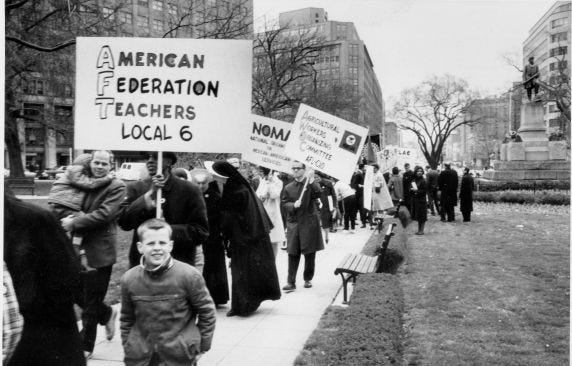
What is the Education Industry?
Since the 1840s, education has industrialized. It has done so in similar ways to the retail, service, logistics, legal, healthcare, hospitality, railroad, construction, maritime, and agricultural industries. Perhaps this is new, or strange, as an idea. Even if you work in education.
Attending school as students, we normally see staff as a team. Not workers in an industry with the same exploitation and disparities of power, privilege, and resources as any other. Educators have managers and bosses. We have bills to pay. If you’re an educator, you already know this all too well. But you might not be used to applying ideas about class struggle and labor exploitation you hear about in other industries. It’s a calling, not a job!
The education industry has products and services, just like any other.
Its product is a person who has been inculcated with the knowledge, ideology, discipline, and culture that primes them to serve the whims of business owners and politicians. The education industry helps reproduce modern society itself. Education also serves as a connecting point—a node—between different industries and social groups with varying levels of power.
An ecological metaphor for the education industry might be fungal organisms. These often form complex underground networks, channeling nutrients and information between plants. These symbiotic relationships help reproduce the wider ecosystem all these lifeforms exist within. Education, in our social ecosystem, intersects with almost every industry.
Daycare workers, nannies, and babysitters—along with the women consigned to housework and unpaid childcare—share with educators the burden of carrying our society across generations. Libraries, museums, and schools are constant, essential sites of family events and social services. Schools enable families to drop their kids off with overworked and underpaid staff so they can go get exploited at their own jobs. Museums curate cultural services for school age children and families. Those services and events help reproduce knowledge and civic traditions. Foisted onto women almost exclusively, this essential work is then looked down on or ignored by a violently patriarchal society.
With that in mind, the education industry includes six major sectors:
1. Public, charter, and private pre-Kindergarten through 12th grade schools.
2. Post-secondary institutions like colleges, universities, and trade schools.
3. Non-profits, foundations, and government departments geared towards education research, funding, and curriculum development.
4. Corporate and government job training and lifelong learning facilities.
5. Cultural institutions like museums and libraries.
6. The amorphous armies of gig tutors and tutoring companies that surround the entire industry.
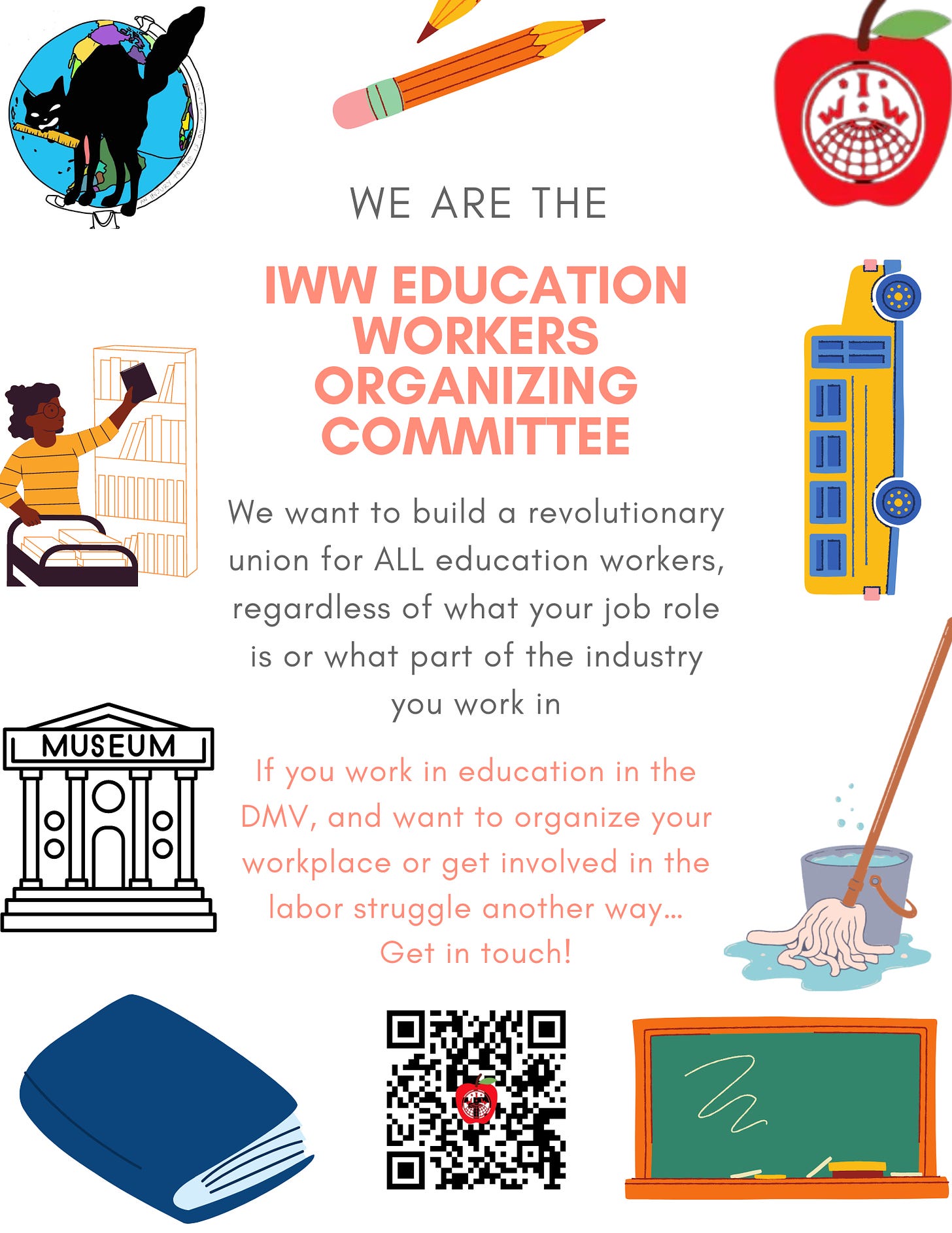
A Union for All Workers
We are members of the Industrial Workers of the World, a non-sectarian radical rank-and-file led labor union for all workers that understands real democracy cannot exist without democracy at work.
Worker-organizers in the IWW understand that our problems as the working class cannot be solved under capitalism. DMV EWOC will help any education workers at unorganized workplaces build militant social justice unions affiliated with the IWW. At the same time, we will support unionized education workers’ efforts to build workplace organizing committees. Ones independent of the mainstream union bureaucracy.
Various forms of oppression harm us, our fellow workers, and the communities we serve. We know free, participatory, and fact-based public education is a right that should be available to all. But our current economic system denies this right to many people. Especially those who are suffering from poverty, systemic discrimination, and state repression. Anti-blackness, racism, colonialism, sexism, heterosexism, cissexism, ableism and other oppressive ideologies erect formidable barriers to worker unity. We must face the fact that the education system of this country was built on stolen indigenous lands with stolen African bodies. Our group commits to criticizing oppressive ideologies as they reveal themselves both in our language and in our behavior. We are committed to acting against oppression when it does occur. Whether it’s between organizers, participants, or bystanders. By uniting education workers across various skills, job roles, cultural backgrounds, and identities, we hope to both improve our working conditions and empower our communities.
We are creating a new and better education system within the ruins of the old.
In our movements for a just education system in the DMV, BIPOC, native born DC residents, LGBTQ2s+, women, and disabled folks should be at the forefront and take up prominent space. Labor organizing in education is directly influenced by feminist principles and concepts. Our committee embraces its feminist inheritance. We are non-hierarchical. We exercise shared organizing responsibility. Our leadership comes primarily from the rank-and-file workers, not elected officers.
The IWW is also the only union in American history that has never segregated its locals. There has never been segregation based on race, gender, sexuality, religion, job role, or anything else.5 They’re a union for all workers. If you’re not a boss, a cop, or a landlord, they’ll welcome you—and fight like hell at your side.
We are committed to industrial, social justice unionism.
This means that every education worker, regardless of job role, should be in the same unions if they’re at the same workplaces. It’s arbitrary to divide education workers who should be struggling together. Our unions should also unite with other social movements. Such as:
- Tenant unions.
- Anti-racist and anti-colonial organizations.
- LGBTQ2s+ coalitions.
- Environmental justice movements.
- Mutual aid groups.
- Migrant solidarity activists.
- Other antifascists of all stripes.
We believe in focusing on the whole worker. You are not just your job.
Rank-and-file education workers in the mainstream unions have started to discover the benefits of this approach for themselves. Caucuses of rank-and file-workers have sprang up inside their trade union locals. Chicago teachers were the first to accomplish this feat. Their Caucus of Rank-and-File Educators (CORE) won union leadership in 2012. Since then, the Chicago Teachers Union (CTU) has united with families, students, communities, and activist groups to pose serious challenges to the corrupt politicians dominating the city and state governments.
Other caucuses have sprouted up all over the place. Another won the leadership of the United Teachers of Los Angeles (UTLA) in 2015. They’ve since launched some of the most inspiring strikes in recent memory. The Washington Teachers Union (WTU) in Washington D.C. has its own CORE that is contending with the incumbent leadership right now.
And of course, the Red for Ed movement organized in ways that got education workers widespread public support. Not only that, these teachers found creative ways to get around draconian anti-labor laws in Republican held states.6
Workers at the Philadelphia Art Museum went on strike for three weeks after formally winning their union. Three weeks on strike is no small feat. Their union was wall-to-wall and enlisted community support on their picket lines every single day. Management completely failed to break the strike or co-opt the workers’ militancy. The workers won every one of their demands.7
In education, industrial organizing paired with social justice unionism clearly gets the goods.
Staff at a charter network with two campuses in the San Francisco Bay Area built a wall-to-wall union with the IWW. Everyone from custodians to office staff to teachers was included. That’s what it means to be an industrial union. ALL workers of the same industry are in the same union. Students, families, and staff well-being were at the center of their demands. Their power at the shop floor has driven management to recognize their union. Even after years of union busting. Unionized staff at the school have outflanked and out organized the bosses at every turn. They are currently negotiating their first union contract.8
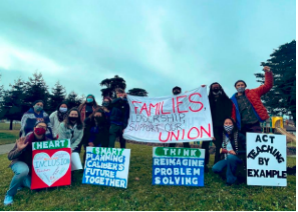
Charter schools are notoriously anti-union. In fact, the main reasons corporate education reformers dreamed them up in the 1980s were to bust teachers’ unions and privatize the schools.9 The repression and intense level of exploitation in these schools makes organizing challenging, but also sorely needed. Less than ten percent of charter school workers are unionized. Mainstream teachers’ unions like the American Federation of Teachers (AFT) and National Education Association (NEA) have actually lost ground in the sector over the last decade. Even as it grows immensely.10 So, the IWW’s recent victories and public campaigns at charter schools—such as the Second Staff campaign in Virginia—are a big deal and represent just the beginning.
Maybe unionizing charter schools sounds like a pipe dream. Maybe it would be best to let politicians handle the problem. Maybe we could pressure them to curtail or ban charters. After all, if the AFT and NEA with all their resources, members, and political clout can’t make it happen, who can?
But the workers at Caliber and the IWW did it. Why not you and your coworkers?
Whether you work or study in charter schools, traditional public schools, libraries, colleges, or anywhere else, the IWW has your back. The Democratic Party does not. We need our students onboard, too.
Students are the raw material of the education industry. So, they’re usually mocked or attacked when they try to reclaim some of their stolen agency. In 1968, New York youth formed the High School Student Union (HSSU). Consciously modeling it after militant labor unions.11 These students fought imaginatively for student power in the school systems and opposed the Vietnam war. Most journalists, politicians, and even their own teachers ignored or disdained their demands. Things are much the same now as they were then. When graduate workers organize, their status as workers is always questioned. Even by many on the left. Few take student struggles seriously. But we in EWOC do.
In 2022, half the incoming freshman class of 2026 at American University walked out of the school’s annual opening ceremony. They joined striking support staff members on the picket line. Administration’s will was already crumbling from the militancy of the strikers. With the university refusing to bargain, these workers had voted to strike from August 22-26. Right during student move in. University administration first tried to turn the student body against the workers. Then otherwise ignored them. That was an abject failure as workers loudly marched around the entire campus. Many of these workers were also students themselves. Unsurprisingly, it was easy to maintain the support of the undergraduates.
Then, administration tried to break the strike. They forced some of the custodial staff to begin moving students’ belongings and furniture into the dorms. Workers and students shut this down and shamed the university publicly. Local city politicians and media outlets spread the story and even offered support to the workers. When the university held its opening ceremony on the final day of the strike, students walked out, chanting “pay your workers!”. After the student walkout, administration accepted defeat. Employers returned to the bargaining table with major concessions. And the workers—affiliated with Local 500 of the SEIU—celebrated a stunning victory.
While the IWW is not as large as the SEIU, they have a vision that can help workers finally cast off subjugation to the rich.
Everyday workers in the IWW lead their own struggles with the guidance and support of a union unique in American history. One that combines over a century of experience with the clarity of a new generation of militant, revolutionary worker organizers.
We recommend that you start talking to your coworkers about issues at work as a first step. There are further trainings offered by the IWW about how to approach and execute these conversations. They happen often, but not constantly. In the meantime, try to keep conversations with coworkers one on one. Staff lounges and classrooms often work. Ideally have them outside work. Even if it’s virtual or over the phone. Once you have a group of coworkers meeting regularly to discuss solving problems with collective action, you can begin to build collective power in your workplace.
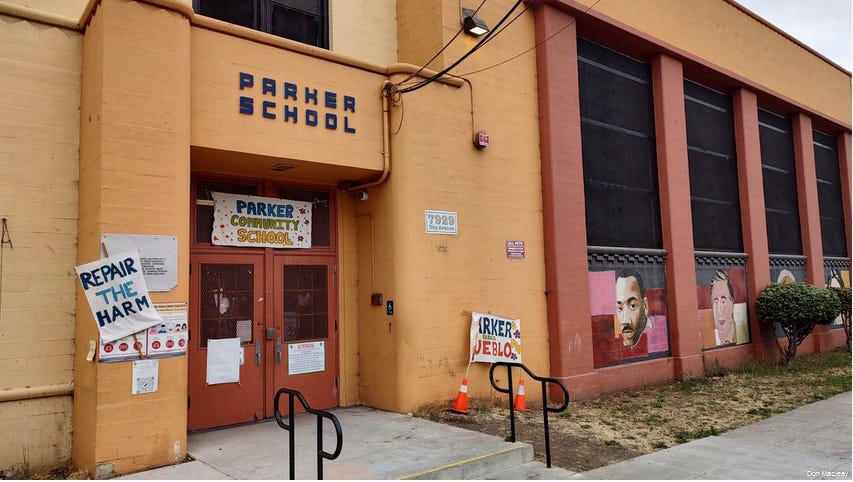
The Need for Revolutionary Change
There isn’t another union in the US that has such a revolutionary stance like the IWW. No other union has such a long tradition of ardent opposition to capitalism. None articulate a concrete plan to overcome capitalism and build the worker-managed economy under socialism. If we care about our students, communities, and ourselves, then we must take up that same struggle. Public education is one of the few institutions in American society and history that has, however imperfectly, afforded opportunity to all. Workers in this country a century and a half ago were mostly illiterate. Today, the vast majority have, at the least, a high school education. We have access to skills and new ways of thinking our ancestors did not. Let’s use them to not just save public education—but to transcend it.
We need truly public institutions. What does that mean? Nationalization? That doesn’t seem quite right. Nationalization is superior to private ownership, of course. But social ownership should be our goal. Much of the education industry in this country is already effectively nationalized. And has been for over a century. It’s still shit to work in.
Schools, libraries, and museums should be controlled by the workers who operate them. In collaboration with the communities they serve. Our administrators and managers exist solely to abuse us until we accept our exploitation. We have nothing in common and we do not need them.
The attacks on protests, LGBTQIA+ folks, Black Americans, educators, and others make it urgent to discuss concretely the need for such revolutionary changes in the education industry such as socialization. This becomes even more urgent when we remind ourselves that there has already a coup attempt: January 6, 2021. ‘Civil war’ seems to be on everyone’s lips these days. Most whisper it with dread. Others recklessly seek to invoke such a catastrophic event. One that will open a Pandora’s Box of violence no one can slam shut. Our situation is dire. It is nothing short of an emergency.
Drag Queen Story Hours and Brunches are fixed in the crosshairs. So are all educators committed to social justice. The benefits for the rich and powerful from stoking their ‘culture wars’ are all too clear. Deployments of hostile mobs of middle-class white people at school board meetings only erode our safety and job security even more. That way, they can silence us.
We are at the threshold of active genocides. Likely beyond it. What we do collectively and individually, right now, matters.
Only revolutionary struggle by and for ourselves as regular people can save us. If you hear revolution, you usually think of violence—blood and ash. But the idea of revolution, held by some, that war on the streets alone can somehow lead to revolutionary change is a dangerous fantasy.
It’s only necessary to look at recent history in Syria to understand. There was a mass mobilization of the working class. They acted against the corruption of the elite, against the lack of democracy, against poverty and unemployment. But when those protests came under armed attack, they weren’t prepared. The people who were ready to exploit the gun battles were sectarian religious groups, foreign states, and the Syrian state itself.
Take it further back, in Sierra Leone during the 1990s. Thousands of gold miners organized with the IWW. But a bloody coup dashed their organizing efforts to pieces. All contact was lost with the lead organizer—Bright Chikezi—for years. How can we prevent our current labor upsurge here from being violently scattered to the wind if shit goes sideways in 2024?
Only through industrial, revolutionary unionism.
What we mean by revolution is the process to get from this society to a new one. These changes can’t be voted in, not by Bernie or the Squad, not by anyone. We want everything we produce to belong to everyone. Not just a few. We want to take back control for real!
But in a way, we mean something that is already happening. When workers take action on the job, they take control and learn how to do things together. If they then coordinate their actions with others, they learn. There are struggles everywhere. Ones where working people take back control for a moment. In these struggles we have to build links across sectors and borders.
We must focus on our productive power as workers.
What does all this mean for us as worker-organizers in education? We have to advance a program that plans for taking over the schools, libraries, museums, archives, and research facilities.
School staff and dockworkers in Oakland offer an instructive example. In 2022, their separate union locals allied to defeat a massive handoff to real estate developers. A handout that would fuel gentrification and school privatization. Eventually, they occupied a closed elementary school. From May to August, they operated the school as a community center. They engaged in food distribution and neighborhood organizing. All while still offering classes to students.
In August, the Oakland Unified School District (OUSD) hired private security. They forced the teachers, port workers, students, and community members out of the building. Video footage shows security agents hitting, shoving, and grappling with the occupiers. How do we defend ourselves? How can we take control of the situation rather than becoming victims?
We want to work towards a pragmatic revolutionary program in close connection to concrete local working-class lives and struggles. There are a few key questions we need to ask our coworkers to do so:
- Do we need administrators, school boards, and superintendents?
- What would it take to keep our workplaces running if we took them over for ourselves and our students?
- What knowledge do we lack? What other workers here and abroad do we depend on?
- How would the local, state, regional, and federal governments react?
This will only be possible if there are independent, rank and file structures or organizations within workplaces.
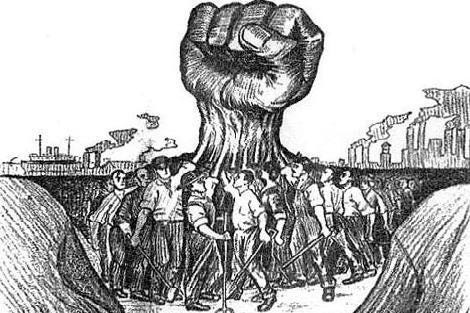
Get Involved!
We in EWOC are actively supporting multiple DMV workplace organizing campaigns. We’d love to help you, too. But if you can’t organize on the shop floor, we always need help with the behind-the-scenes administrative work. Work that makes great organizing possible. Many hands make light work, as they say. Above all, we are always looking for folks willing to train to be external organizers for our worker organizer leads. That way, we can build our presence in the region’s education industry and fight for real gains and revolutionary power across the entire system. Right now, we also need help with outreach, reporting on our campaigns to IWW General Headquarters, and social media work.
Don’t know how to do something, but want to learn? We will teach you.
Get in touch!
DMVeducationworkers@protonmail.com
Get in touch through our linktree!
Or fill out our form to speak directly with an organizer!
1 Cathie. 2022. “The Struggle Of College Graduates Working Low-Paying Jobs – List Foundation.” Jobs and careers. List Foundation Blog (blog). October 22, 2022.https://www.listfoundation.org/the-struggle- of-college-graduates-working-low-paying-jobs.
Matthews, Steve. 2017. “College Grads Stuck with Low Wages.” Panama City News Herald, 2017, sec. Business.https://www.newsherald.com/story/business/2017/04/06/college-grads-stuck-with-low- wages/21551122007/.
2 Wingard, Jason. 2022. “Higher Ed Must Change or Die.” Inside Higher Ed, August 17, 2022. https://news.temple.edu/news/2022-08-17/higher-ed-must-change-or-die.
3 Burnette, D. 2020. “Budget Cuts Devastated Academics During the Last Recession, New Research Finds.” Education Week, August 2020. http://blogs.edweek.org/edweek/campaign-k- 12/2020/08/budget_cuts_during_the_last_re.html?cmp=SOC-SHR-FB.
4 Rooks, Noliwe. 2017. Cutting School: Privatization, Segregation, and the End of Public School. New York: The New Press.
5 Foner, Philip. 1970. “The IWW and the Black Worker.” The Journal of Negro History 55 (1): 45– 64. https://files.libcom.org/files/Foner_PS_-_The_IWW_and_the_Black_Worker.pdf.
6 Blanc, Eric. 2020. “The Red for Ed Movement, Two Years In.” New Labor Forum, October. https://newlaborforum.cuny.edu/2020/10/03/the-red-for-ed-movement-two-years-in/.
7 The Associated Press. 2022. “Philadelphia Museum of Art Workers Ratify Pact, End Strike.” ABC News, October 17, 2022. https://abcnews.go.com/Entertainment/wireStory/philadelphia-museum-art-workers-ratify- pact-end-strike-91628879.
8 Colgan, Cal. 2021. “Charter School Workers’ Year-Long Fight for Recognition.” Industrial Worker (blog). June 30, 2021.https://industrialworker.org/caliber_fight_july2021/; https://caliberworkers.org/
9 Rooks, Noliwe. 2017. Cutting School: Privatization, Segregation, and the End of Public School. New York: The New Press.
10 National Alliance for Public Charter Schools. 2020. “Unionized Charter Schools: Data from 2018- 19.” Reseearch and Evaluation. publiccharters.org/sites/default/files/documents/2021- 01/napcs_unionization_rd3.pdf.
11 Buffett, N.P. 2019. “Crossing the Line: High School Student Activism, the New York High School Student Union, and the 1968 Ocean Hill-Brownsville Teachers’ Strike.” Journal of Urban History 45: 1212–36.
